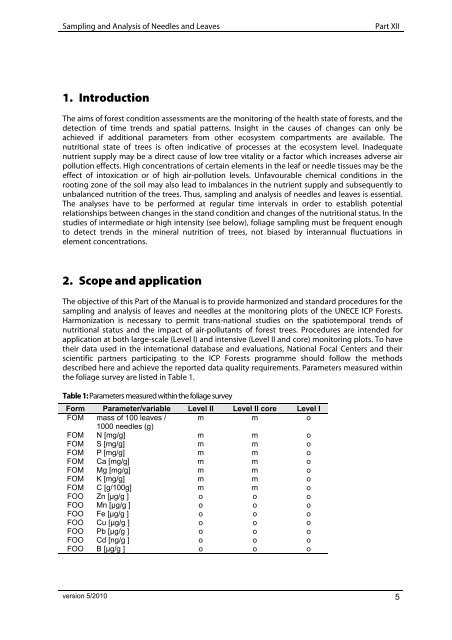Download - ICP Forests
Download - ICP Forests
Download - ICP Forests
You also want an ePaper? Increase the reach of your titles
YUMPU automatically turns print PDFs into web optimized ePapers that Google loves.
Sampling and Analysis of Needles and Leaves<br />
Part XII<br />
1. Introduction<br />
The aims of forest condition assessments are the monitoring of the health state of forests, and the<br />
detection of time trends and spatial patterns. Insight in the causes of changes can only be<br />
achieved if additional parameters from other ecosystem compartments are available. The<br />
nutritional state of trees is often indicative of processes at the ecosystem level. Inadequate<br />
nutrient supply may be a direct cause of low tree vitality or a factor which increases adverse air<br />
pollution effects. High concentrations of certain elements in the leaf or needle tissues may be the<br />
effect of intoxication or of high air-pollution levels. Unfavourable chemical conditions in the<br />
rooting zone of the soil may also lead to imbalances in the nutrient supply and subsequently to<br />
unbalanced nutrition of the trees. Thus, sampling and analysis of needles and leaves is essential.<br />
The analyses have to be performed at regular time intervals in order to establish potential<br />
relationships between changes in the stand condition and changes of the nutritional status. In the<br />
studies of intermediate or high intensity (see below), foliage sampling must be frequent enough<br />
to detect trends in the mineral nutrition of trees, not biased by interannual fluctuations in<br />
element concentrations.<br />
2. Scope and application<br />
The objective of this Part of the Manual is to provide harmonized and standard procedures for the<br />
sampling and analysis of leaves and needles at the monitoring plots of the UNECE <strong>ICP</strong> <strong>Forests</strong>.<br />
Harmonization is necessary to permit trans-national studies on the spatiotemporal trends of<br />
nutritional status and the impact of air-pollutants of forest trees. Procedures are intended for<br />
application at both large-scale (Level I) and intensive (Level II and core) monitoring plots. To have<br />
their data used in the international database and evaluations, National Focal Centers and their<br />
scientific partners participating to the <strong>ICP</strong> <strong>Forests</strong> programme should follow the methods<br />
described here and achieve the reported data quality requirements. Parameters measured within<br />
the foliage survey are listed in Table 1.<br />
Table 1: Parameters measured within the foliage survey<br />
Form Parameter/variable Level II Level II core Level I<br />
FOM mass of 100 leaves / m m o<br />
1000 needles (g)<br />
FOM N [mg/g] m m o<br />
FOM S [mg/g] m m o<br />
FOM P [mg/g] m m o<br />
FOM Ca [mg/g] m m o<br />
FOM Mg [mg/g] m m o<br />
FOM K [mg/g] m m o<br />
FOM C [g/100g] m m o<br />
FOO Zn [µg/g ] o o o<br />
FOO Mn [µg/g ] o o o<br />
FOO Fe [µg/g ] o o o<br />
FOO Cu [µg/g ] o o o<br />
FOO Pb [µg/g ] o o o<br />
FOO Cd [ng/g ] o o o<br />
FOO B [µg/g ] o o o<br />
version 5/2010 5
















